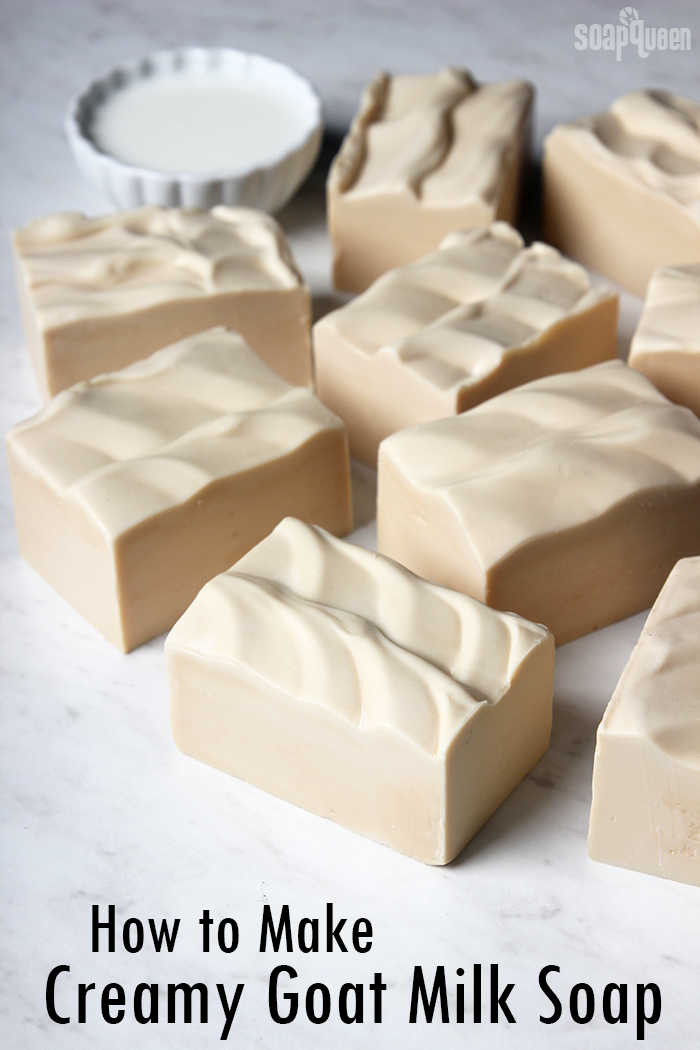
Goat milk soap is well known for its creamy lather and skin-loving properties. Goat milk is particularly nourishing because of capric-caprylic triglyceride, which helps form a barrier on the skin to help inhibit the loss of moisture. Goat milk also contains vitamins A, D and B6, as well lactic acid which is thought to contribute to skin smoothness. It’s no wonder why goat milk soap is loved by so many!
This goat milk soap recipe contains goat milk from a local farm. Using fresh goat milk is a fantastic way to highlight local products and the unique, handmade properties of your goat milk soap. If you can’t get your hands on fresh goat milk in your area, powdered goat milk is a great alternative. You may also find goat milk at your local grocery store, co-op or farmer’s market.
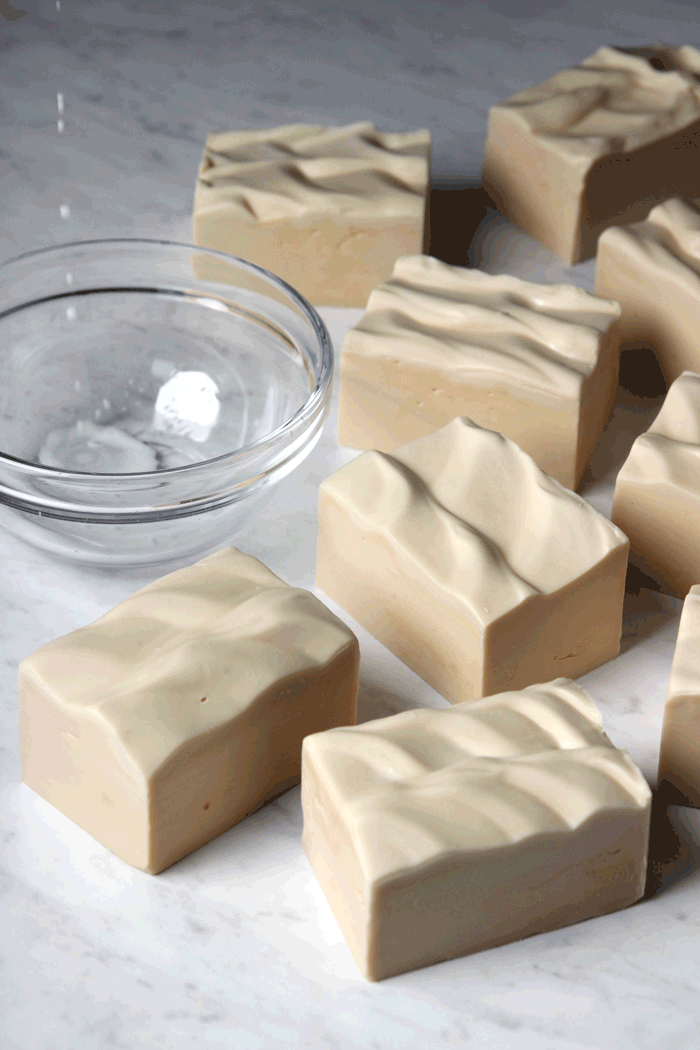
Creating goat milk soap does take some extra prep work. If you’ve never tried making milk soap before, you may want to get a simpler cold process soap recipe under your belt first (this one is great!). Adding lye to milk can scorch the milk without proper preparation. Freezing the milk first keeps temperatures cool and prevents scorching. Learn how to prep milk for milk soap, and watch this Goat Milk Soap video to see the process in action.
If you’re ready to dive into goat milk soap for the first time, this recipe is perfect. It’s simple with one color and a thick texture, so no need to worry stick blending too much. It’s scented with Oatmeal Milk and Honey, one of our all-time most popular fragrance oils. It does discolor in cold process soap, so titanium dioxide is added to keep the bars light and creamy looking. There is something so appealing about a simple bar of creamy milk soap!
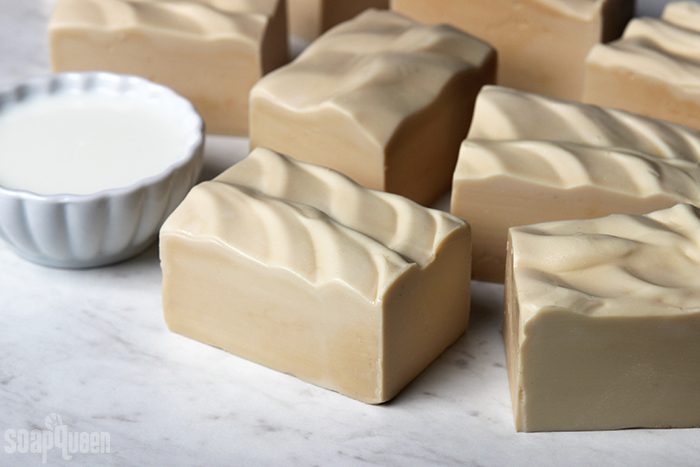
What You’ll Need:
9 Bar Birchwood Mold
Silicone Liner for 9 Bar Mold
5.3 Apricot Kernel Oil (15%)
8.8 oz. Coconut Oil (25%)
11.5 oz. Olive Oil Pomace (33%)
2.5 oz. Cocoa Butter Cubes (7%)
7 oz. Palm Oil (20%)
4.9 oz. Sodium Hydroxide Lye
11.6 oz. Goat Milk
2 oz. Oatmeal Milk and Honey Fragrance Oil
Titanium Dioxide

Click here to add everything you need for this project to your Bramble Berry shopping cart!
MILK PREP: When lye is added to milk, it causes the milk to reach temperatures up to 200 ° F. This scorches the milk, causing it to smell bad and develop a dark yellow color. A technique to prevent the milk from scorching is to keep temperatures as cool as possible. Our preferred technique is to freeze the goat milk, and add the sodium hydroxide lye flakes directly to the frozen milk. To keep the milk extra, extra cold, you can place the container of frozen milk into a larger container with ice. In this project we skipped this step, but it’s a personal preference.
First, measure out 11.6 ounces of goat milk. Then, pour the milk into ice cube trays (in this case we used Medium 9 Ball Silicone Molds). Allow the milk to fully freeze. Once frozen, empty the milk ice cubes into a container appropriate for mixing lye. When adding the milk ice cubes to the container, place the container on a scale to make sure you have the correct amount of milk. Although it was measured previously, some milk might be lost in the freezing/transferring process. If you’re missing some milk, pour cold goat milk into the container to supplement what you have. Adding distilled water to supplement would also be okay.
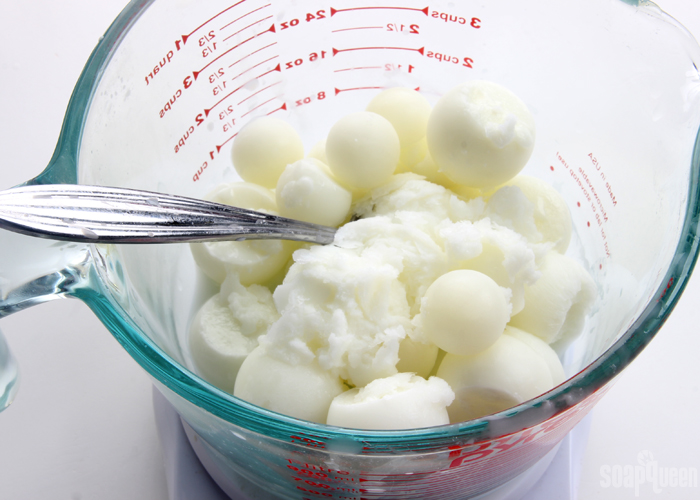 SAFETY FIRST: Suit up for safe handling practices! That means goggles, gloves and long sleeves. Make sure kids, pets, and other distractions and tripping hazards are out of the house or don't have access to your soaping space. Always soap in a well-ventilated area.
SAFETY FIRST: Suit up for safe handling practices! That means goggles, gloves and long sleeves. Make sure kids, pets, and other distractions and tripping hazards are out of the house or don't have access to your soaping space. Always soap in a well-ventilated area.
LYE PREP: With safety gear on, slowly add about 1/4 of the lye flakes directly to the frozen goat milk. Use a non-reactive spoon to stir the lye flakes and goat milk together. Slowly, the flakes will begin to melt the goat milk cubes. After a few minutes of stirring, add another 1/4 of the flakes and continue stirring for several minutes.
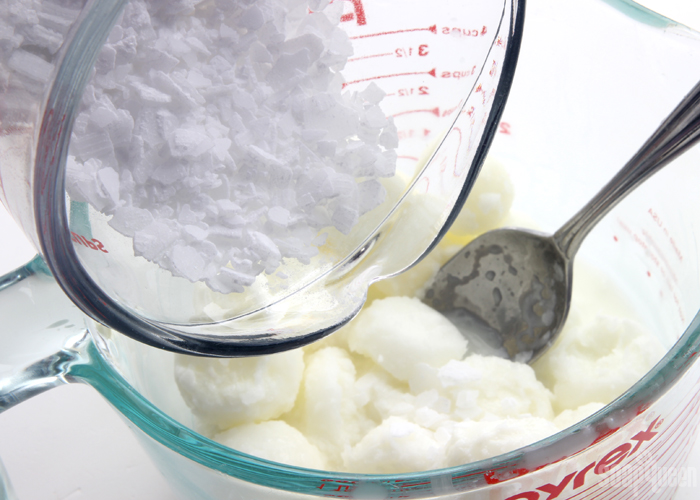
Continue this process until all the lye flakes have been added to the goat milk. Continue stirring and stirring…and stirring! The goat milk will continue to melt as more lye is added and stirred. Once the milk has fully melted, continue to stir to make sure all the lye flakes have completely dissolved. Because the temperatures are low, the lye flakes do not dissolve as quickly. Listen and look for lye flakes on the bottom of your container; lye flakes can take a lot longer to dissolve in cooler temperature liquids. Patience is key! Any undissolved lye in your soap could cause skin irritation, or even lye burns, so take extra time to make sure all the lye is dissolved.
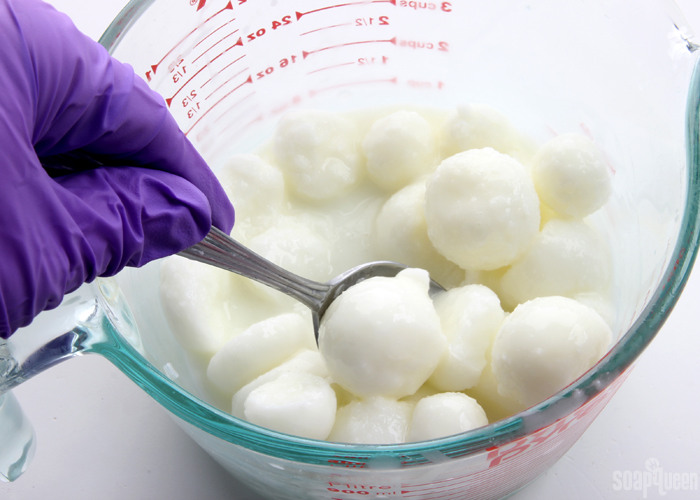
Once all the lye has been added, the milk may become yellow. Below, our milk reached about 90 ° F and developed a very slight yellow color. This color of milk is suitable for this recipe. But, if you’d like to make sure your soap batter is as light as possible for your color palette, placing the container of frozen milk into an ice bath container helps keep temperatures cooler, as shown in this post. If you'd like a harder bar of soap that releases faster from the mold, you can add sodium lactate to the milk solution. Use 1 teaspoon of sodium lactate per pound of oils in the recipe. For this recipe, you'd add 2 teaspoons sodium lactate.
Now that the lye and milk solution is prepped, it’s time to prep the other ingredients.
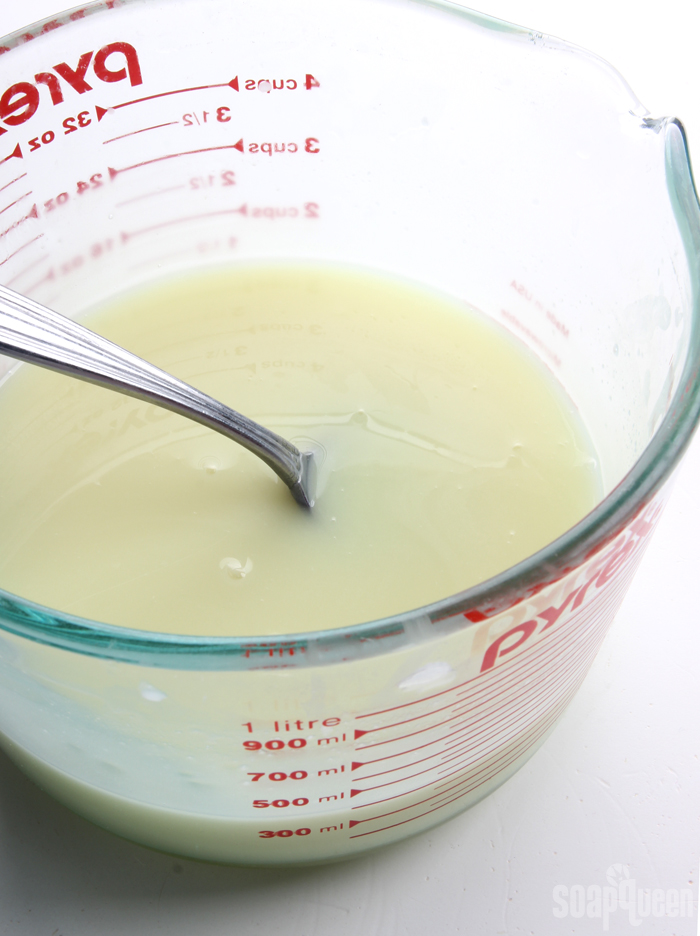 COLOR PREP: To ensure that the titanium dioxide blends smoothly into the soap batter, we recommend micronizing it before dispersing it in oil. Please note this is an optional tip but it does help with the titanium dioxide clumping in the soap. =) To micronize colorant, simply use a coffee grinder to blend the colorant to break up any clumps of color and prevent streaks of white from showing in the final soap. We like to use a coffee grinder that has a removable, stainless steel mixing area for easy cleaning. Disperse 3 teaspoons of titanium dioxide into 2 tablespoons of lightweight liquid oil, like sweet almond oil or sunflower oil. In this recipe, we used a slightly more concentrated colorant-oil ratio to avoid adding too much extra oil.
COLOR PREP: To ensure that the titanium dioxide blends smoothly into the soap batter, we recommend micronizing it before dispersing it in oil. Please note this is an optional tip but it does help with the titanium dioxide clumping in the soap. =) To micronize colorant, simply use a coffee grinder to blend the colorant to break up any clumps of color and prevent streaks of white from showing in the final soap. We like to use a coffee grinder that has a removable, stainless steel mixing area for easy cleaning. Disperse 3 teaspoons of titanium dioxide into 2 tablespoons of lightweight liquid oil, like sweet almond oil or sunflower oil. In this recipe, we used a slightly more concentrated colorant-oil ratio to avoid adding too much extra oil.
FRAGRANCE PREP: Measure 2 ounces of Oatmeal Milk and Honey Fragrance Oil into a glass, fragrance oil safe container. Set aside.
ONE: Fully melt and combine the coconut oil, palm oil, olive oil pomace, cocoa butter, apricot kernel oil (remember to fully melt then mix your entire container of palm oil before portioning). Once the oils have cooled to 130 degrees or below (the milk lye solution will be on the cooler side, that’s okay), add the Oatmeal Milk and Honey Fragrance Oil directly to the oils. Usually fragrance oils are added at trace, but because we know this fragrance behaves so well and thin trace is not a concern, it can be added first.
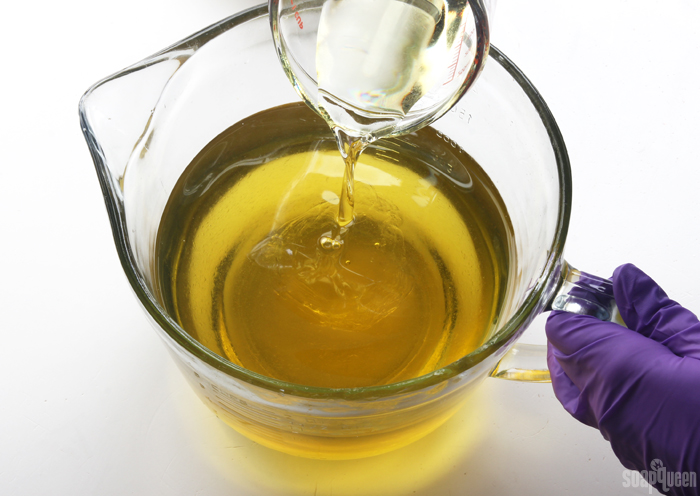 TWO: Add the milk and lye solution slowly to the oils. As you add the milk, begin pulsing your stick blender. Because the milk and lye solution is on the cooler side and the recipe contains hard oils that solidify at cooler temperature, adding the lye and milk solution gradually can help prevent false trace.
TWO: Add the milk and lye solution slowly to the oils. As you add the milk, begin pulsing your stick blender. Because the milk and lye solution is on the cooler side and the recipe contains hard oils that solidify at cooler temperature, adding the lye and milk solution gradually can help prevent false trace.
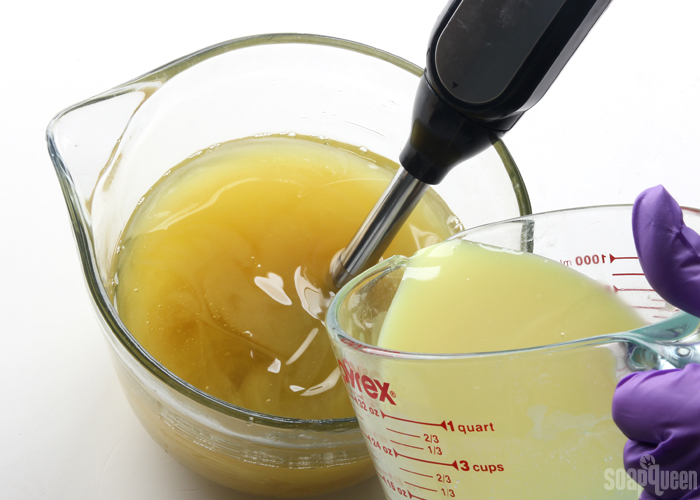 THREE: Once all the lye solution has been added, continue to blend until thin to medium trace.
THREE: Once all the lye solution has been added, continue to blend until thin to medium trace.
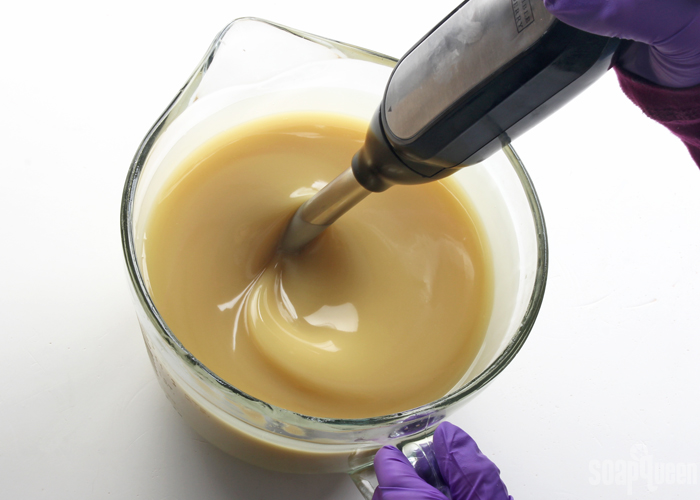
FOUR: Add all the dispersed titanium dioxide, and use the stick blender to stir and blend the colorant into the batter using short bursts.
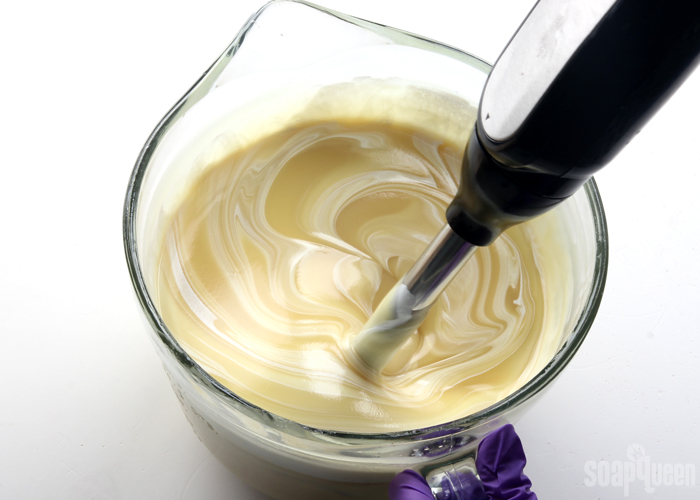
FIVE: Once the colorant is completely incorporated, pour the soap into the mold. Tap it firmly on the counter to eliminate air bubbles, and use a spoon or spatula to spread the soap evenly into the mold.
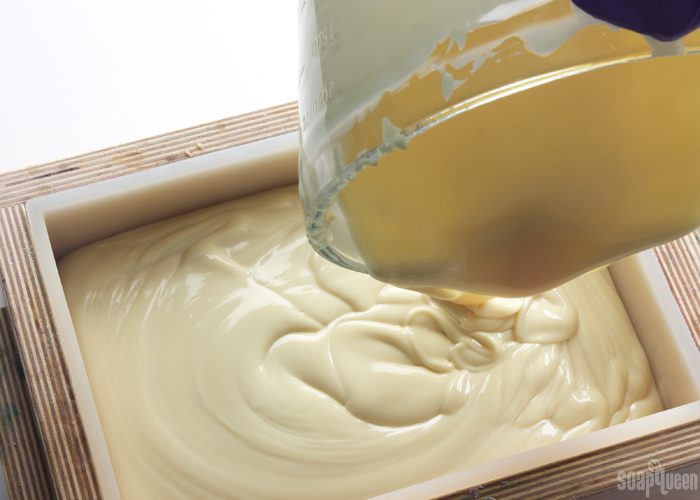 SIX: Using a small stainless steel spoon, create texture on the top of the soap. There is no right or wrong way to do this, so have fun with it!
SIX: Using a small stainless steel spoon, create texture on the top of the soap. There is no right or wrong way to do this, so have fun with it!
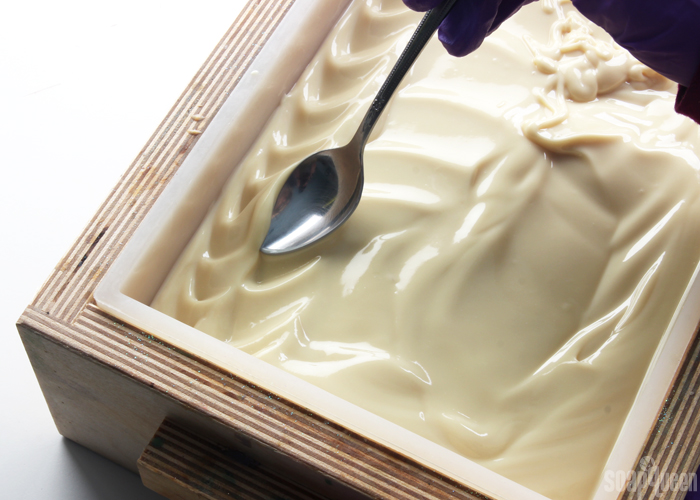 SEVEN: Once you’re happy with the top, insert the dividers into the mold. Push the dividers all the way to the bottom of the mold. Spray the top of the soap with 99% isopropyl alcohol to help avoid soda ash. Milk soap has a tendency to heat up due to the sugar in the milk. To keep it cool, place the soap in the fridge or freezer for at least 3 hours, up to overnight. Then, allow it to sit in the mold for about 3-4 days. Soap that is placed in the fridge or freezer for the first few hours of saponification can take a little longer to unmold. If you find the silicone liner is not pulling away from the sides of the mold easily, give it another day to unmold. Remove the soap from the dividers (see the unmolding process in this video here) and allow the bars to cure for 4-6 weeks. Enjoy your goat milk soap!
SEVEN: Once you’re happy with the top, insert the dividers into the mold. Push the dividers all the way to the bottom of the mold. Spray the top of the soap with 99% isopropyl alcohol to help avoid soda ash. Milk soap has a tendency to heat up due to the sugar in the milk. To keep it cool, place the soap in the fridge or freezer for at least 3 hours, up to overnight. Then, allow it to sit in the mold for about 3-4 days. Soap that is placed in the fridge or freezer for the first few hours of saponification can take a little longer to unmold. If you find the silicone liner is not pulling away from the sides of the mold easily, give it another day to unmold. Remove the soap from the dividers (see the unmolding process in this video here) and allow the bars to cure for 4-6 weeks. Enjoy your goat milk soap!
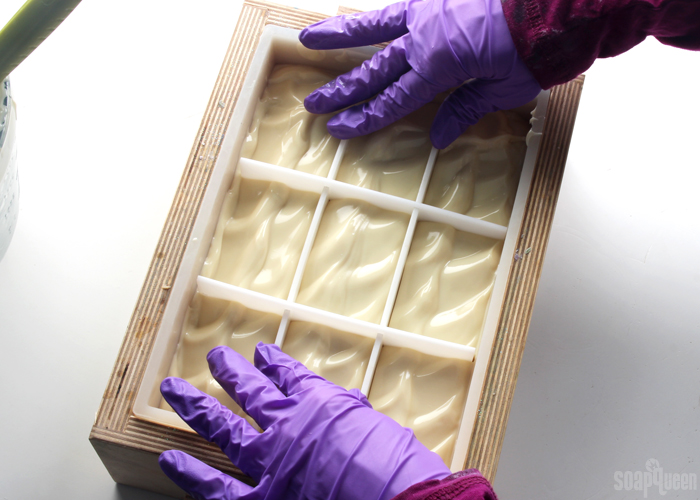
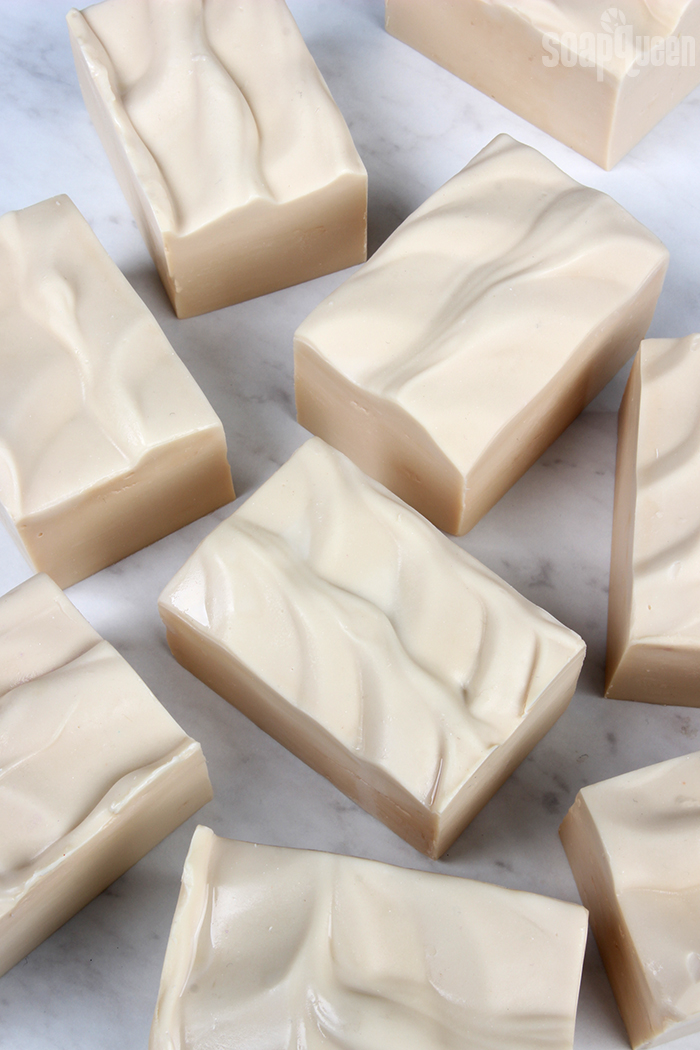
Creamy Goat Milk Soap Recipe
- 9 Bar Birchwood Mold
- Silicone Liner for 9 Bar Mold
- 5.3 Apricot Kernel Oil (15%)
- 8.8 oz. Coconut Oil (25%)
- 11.5 oz. Olive Oil Pomace (33%)
- 2.5 oz. Cocoa Butter Cubes (7%)
- 7 oz Palm Oil (20%)
- 4.9 oz. Sodium Hydroxide Lye
- 11.6 oz. Goat Milk
- 2 oz. Oatmeal Milk and Honey Fragrance Oil
- Titanium Dioxide
- Fully melt and combine the coconut oil, olive oil pomace, cocoa butter, apricot kernel oil, and palm oil (remember to fully melt then mix your entire container of palm oil before portioning). Once the oils have cooled to 130 degrees or below (the milk lye solution will be on the cooler side, that's okay), add the Oatmeal Milk and Honey Fragrance Oil directly to the oils. Usually fragrance oils are added at trace, we know this fragrance behaves so well and thin trace is not a concern, it can be added first.
- Add the milk and lye solution slowly to the oils. As you add the milk, begin pulsing your stick blender. Because the milk and lye solution is on the cooler side and the recipe contains hard oils that solidify at cooler temperatures, adding the lye and milk solution gradually can help prevent false trace.
- Once all the lye solution has been added, continue to stick blend until you reach thin to medium trace.
- Add all the dispersed titanium dioxide, and use the stick blender to stir and blend the colorant into the batter using short bursts.
- Once the colorant is completely incorporated, pour the soap into the mold. Tap it firmly on the counter to eliminate air bubbles, and use a spoon or spatula to spread the soap evenly into the mold.
- Using a small stainless steel spoon, create texture on the top of the soap. There is no right or wrong way to do this, so have fun with it!
- Once you're happy with the top, insert the dividers into the mold. Push the dividers all the way to the bottom of the mold. Spray the top of the soap with 99% isopropyl alcohol to help avoid soda ash. Milk soap has a tendency to heat up due to the sugar in the milk. To keep it cool, place the soap in the fridge or freezer for at least 3 hours, up to overnight. Then, allow it to sit in the mold for about 3-4 days. Soap that is placed in the fridge or freezer for the first few hours of saponification can take a little longer to unmold. If you find the silicone liner is not pulling away from the sides of the mold easily, give it another day to unmold. Remove the soap from the dividers (see the unmolding process in this video here) and allow the bars to cure for 4-6 weeks. Enjoy!
3.3.3077
The post Creamy Goat Milk Soap Recipe appeared first on Soap Queen.
Keine Kommentare:
Kommentar veröffentlichen